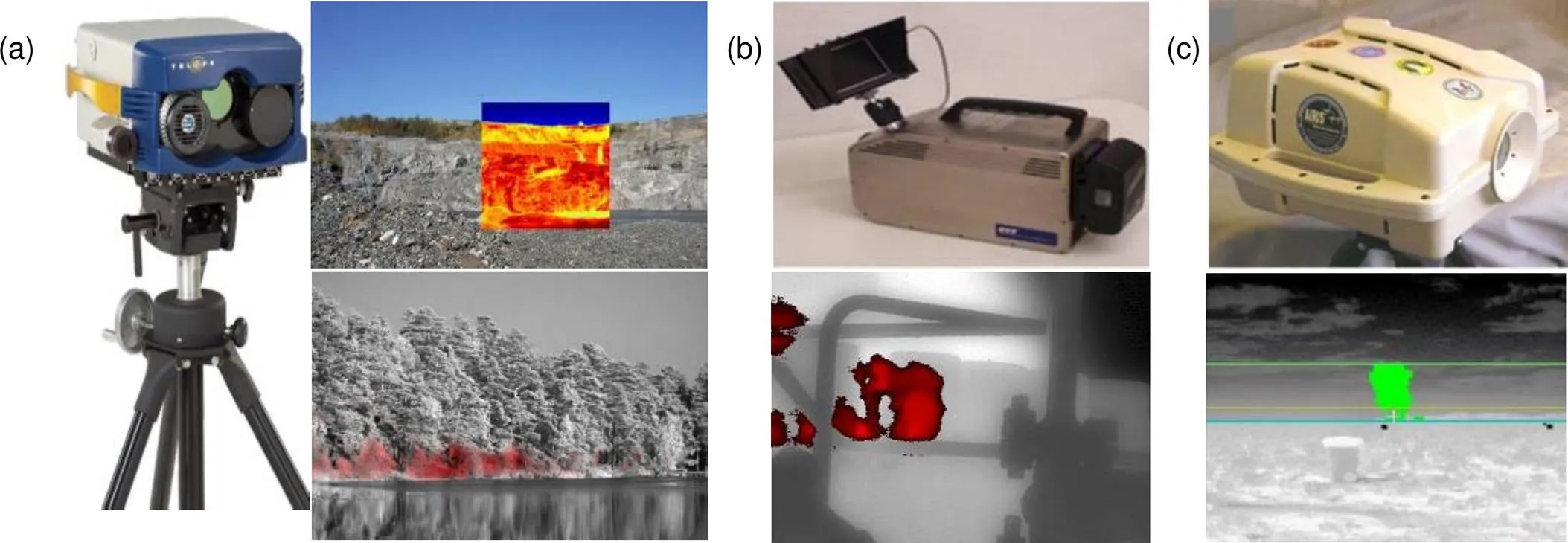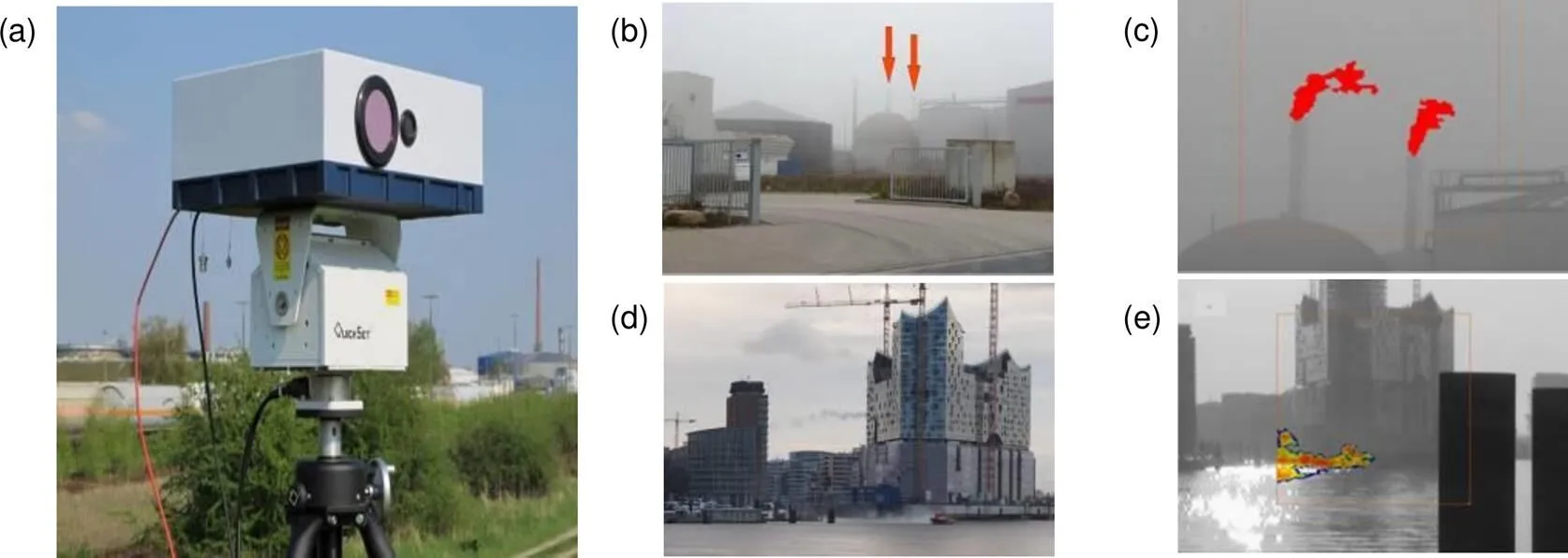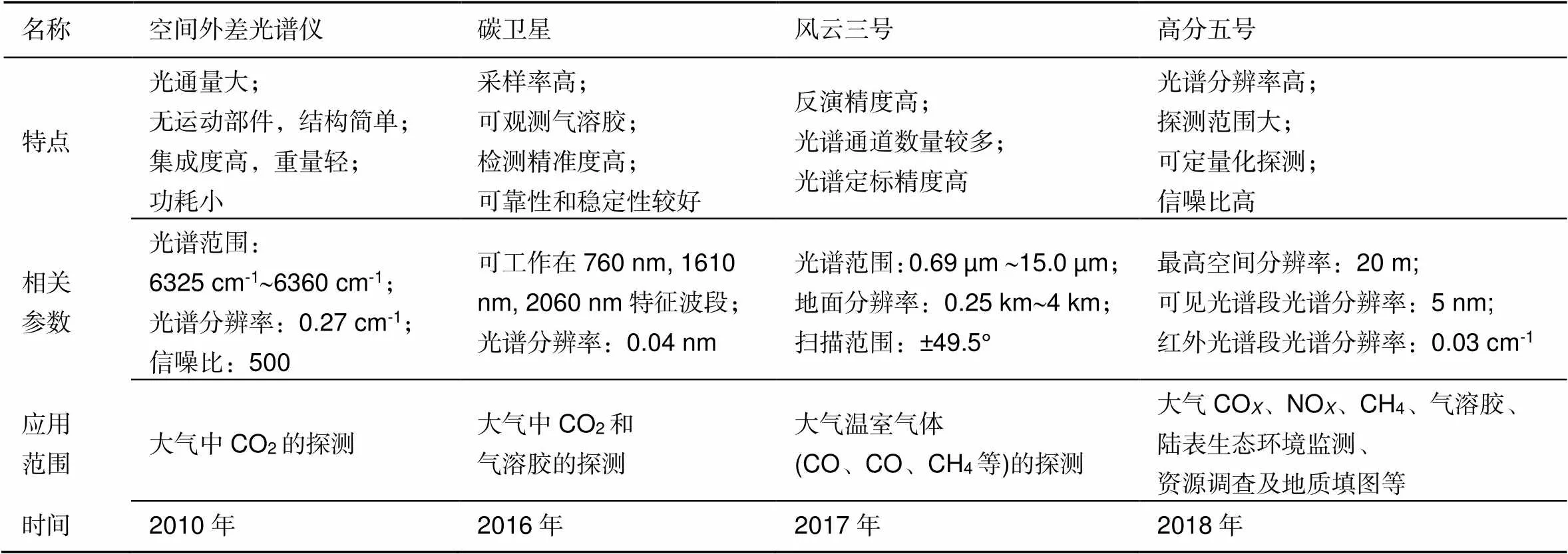气体光学检测技术及其应用研究进展
2020-04-23邵昆明郭禹泽
沈 英,邵昆明,吴 靖,黄 峰,郭禹泽
气体光学检测技术及其应用研究进展
沈 英,邵昆明,吴 靖*,黄 峰,郭禹泽
福州大学机械工程及自动化学院,福建 福州 350116
气体的快速识别与检测已成为国内外研究者迫切解决的重大问题。随着光学技术的快速发展,气体光学检测技术以其高效率、多组分、高灵敏度等显著优势而成为气体检测领域的重要研究热点之一。本文介绍了气体光学检测技术的理论基础,并按主动式与被动式两大类综述了各种典型气体光学检测技术的工作原理及应用进展。运用这些气体检测技术,已经对几十种气体实现远距离、高灵敏度的连续实时监测,完成了多种场景下对气体成分、浓度、温度等参数的测量,有效减少了危险事故的发生。通过总结和分析现有气体光学检测技术仍存在的技术问题,对未来的发展趋势进行了展望。
气体光学检测;吸收光谱法;主动式检测;被动式检测;光谱成像
1 引 言
随着全球经济的快速发展,人们对能源和化工原料的需求日益增加,虽然这些能源和化工原料为日常生活带来极大的便利和改善,但与之俱来的各个领域的气体泄漏事故却时有发生。常用的易燃易爆气体如石油气、甲烷和氯乙烯等可能会因泄露而引发爆炸、火灾等事故。2018年11月,河北省张家口市中国化工集团河北盛华化工有限公司氯乙烯气柜发生泄漏并扩散到厂区外公路上,遇明火发生爆燃,致多人死亡。类似这种气体泄漏事故还会导致巨大的经济损失。此外,一些无毒、无味和看似无害的气体,也会对人类生活环境造成极大危害。例如,通常用于电力系统的SF6气体和诸如生产生活中排放的CO2之类的气体将导致温室效应,造成全球气候变暖。
因此,发展气体检测技术,实现在各种场景下快速、定性、定量地识别和探测有害气体,防止危险事故的发生,成为当前研究人员迫切解决的问题。
传统气体检测主要是人工采样[1]和预处理采样[2]。传统化学测量方法,包括化学反应方法、电化学法、色谱及质谱相关技术,都属于人工采样的方式。人工取样后,将试样进行分离、富集和掩蔽,通过特定的化学反应或计量关系,只能在实验室对气体进行分析,或进行现场初步定性定量的分析。预处理采样是将预处理的测量气体输送到测量管中,并通过测量安装在管道两端的光学探头(红外或紫外探头)来测量气体的浓度。由于传统气体传感器的接触性原理,使其难以实现远距离精确测量,且大多数传统气体传感器(电化学气体传感器、PID气体传感器等)只能对目标气体进行单点监测[3-4],难以满足大范围实时动态监测。
随着光谱成像技术的发展,光谱学方法发展日趋迅速,相比于传统的气体检测方法,光谱法不需要样品制备,具有快速、非侵入、高效和动态等优点,适用于现场快速检测和连续实时在线分析,成为各国研究和应用的热点。本文首先介绍气体光学检测技术的理论基础及工作原理,其次对气体光学检测的技术特点及应用领域进行了归纳对比,重点阐述了各检测技术的应用研究现状,最后对气体光学检测技术的发展与应用进行总结与展望。
2 理论基础
2.1 分子吸收光谱理论



图14 (a) FIRST气体成像光谱仪及应用;(b) Sherlock VOC气体成像光谱仪及应用;(c) AIRIS-WAD自适应红外成像光谱仪及应用
目前,7mm~14mm长波红外高光谱成像技术(longwave infrared hyperspectral imaging,LWIR-HSI)基于气体排放物的强光谱特征而迅速发展起来[58],可实现对气体、资源及海洋等领域的探测。Kastek等[59]使用Telops公司生产的HyperCAM LWIR高光谱探测仪(其探测分辨率320´256,光谱分辨率0.25 cm-1~150 cm-1),在实验室中(泄露量为5 mg/s,浓度为1%)得到了不同热对比度值下CO2、NO2吸收光谱特性的变化;在外场试验中可探测CO2最低浓度约1%,并成功探测到60 m远处浓度为3%的四氟乙烷(CH2FCF3)。土耳其中东技术大学的Omruuzun等[60]提出了基于黑体辐射曲线补偿的LWIR高光谱成像仪,其波段范围为1285 cm-1~877 cm-1,光谱分辨率约3.32 cm-1,谱带数为124,对挥发的甲醇气体进行探测,验证了基于消除像素特征突出部分的黑体辐射曲线补偿方法对提高气体分辨能力的有效性。德国汉堡大学的Sabbah等[61]使用HI 90 LWIR成像仪,对雾天250 m外的泄露CH4进行监测,得到不同光谱范围的亮温图,该仪器通过使用5 pixel´5 pixel大小的空间高斯滤光片对高光谱数据立方体进行预处理,以消除光谱噪声影响,有效提高了气体云团的可分辨性;同时对水面小船上泄露速率为8 g/s~10 g/s的SF6气体进行了探测,验证了该仪器对不同天气条件下不同气体的适用性,如图15所示。昆明物理研究所的郑为建等设计出了基于时空调制干涉原理的LWIR时空调制高光谱成像实验装置CHIPED-1,其光谱响应范围可以达到11.5mm左右,单次采样NESR可达5.6´10-8(W/cm2)×(Sr/cm),实现对NH3、乙醚(C4H10O)、SF6及VOCs的高灵敏度光谱探测[62-63],证明了相对于宽波段热成像技术,CHIPED-1在VOCs的二维光谱探测中具有灵敏度更高、抗干扰能力更强的优势。

图15 实验装置及结果图。(a) HI 90高光谱成像仪;(b)~(c) 甲烷的探测场景及结果;(d)~(e) SF6的探测场景及结果[61]
随着技术的发展,传统多光谱遥感成像及陆基高光谱遥感成像技术因受站点位置及空间分辨率较低的限制而难以满足对大气监测的精度要求,对此,星载高光谱遥感技术引起了国内外研究者的广泛关注。
国外研究人员早先涉足该领域。2009年1月,日本宇宙航空开发研究机构(JAXA)发射了全球第一颗温室气体探测卫星GOSAT,它配备了温室气体探测仪(TANSO)和云气溶胶成像仪(CAI)。在0.75mm~0.78mm波段探测O2浓度和卷云,得出路径长度,在1.56mm~1.72mm和1.92mm~2.08mm波段观测水汽、CH4、CO2和卷云,在5.5mm~14mm波段再次获得水汽、CH4和CO2等参数及CH4和CO2垂直廓线,三个波段范围中光谱分辨率分别为0.5 cm-1、0.2 cm-1和0.2 cm-1[64]。2018年10月,JAXA发射了GOSAT-2温室气体探测卫星,与GOSAT相比,GOSAT-2可以获得更多的有效观测次数,信噪比更高。除此以外,其上搭载的CAI-2观测仪还能够有效克服海面耀斑的影响,实现对海洋上空气体的探测[65]。2014年7月,NASA发射了OCO-2卫星[66],其载荷为高光谱与高空间分辨率CO2探测仪,光谱通道数为1016个,能够探测0.758mm~0.772mm、1.594mm~1.619mm和2.042mm~2.082mm三个吸收光谱通道,地面幅宽为10.6 km,光谱分辨率分别为0.5 cm-1、0.3 cm-1和0.2 cm-1,该技术可以工作在星下、耀斑和目标三种观测模式下,实现对不同应用场景下CO2的高分辨率测量[67]。美国计划将在2023年发射新一代搭载高光谱和红外载荷的对地观测卫星HyspIRI[68],主要用于生态系统和碳循环等科学研究,其光谱分辨率为10 nm,光谱通道数为212个,光谱范围为0.38mm~2.5mm,地面像元分辨率和幅宽分别为60 m和145 km。

表3 我国星载高光谱遥感技术
近年来,我国在星载高光谱遥感领域的研究也取得了重大突破,空间分辨率、光谱分辨率和数据传输速度等一些技术指标已达到国际先进水平,填补了我国运用星载高光谱遥感技术监测大气环境的空白。目前,国内在该领域已研制成功且比较典型的技术有空间外差光谱仪(spatial heterodyne spectroscopy,SHS)、碳卫星高光谱CO2探测仪(TanSat CO2spectrometer,TSCS)、风云三号高光谱温室气体监测仪(FY-3D greenhouse gases absorption spectrometer,GAS)、高分五号(GF-5)等四种,表3列举了我国几种星载高光谱遥感技术的相关信息。其中GF-5是我国第一颗高光谱综合监测卫星,可从紫外到长波红外波段获取高光谱高分辨率数据,其上共搭载了六台载荷如图16所示,并列出了观测卫星对地成像和大气探测工作谱段,具有高精度、高灵敏度和高光谱分辨率的优势[69]。
光谱成像技术在气体检测领域主要适用于大气环境气体、温室气体、大气痕量气体和气溶胶等气体的监测,因其更高的空间和光谱分辨率,结合先进的后端成像处理技术,可获得更高的气体浓度检测分辨率。未来光谱成像技术还需向以下方向更新改进:构建更加全面的地物光谱数据库,丰富数据采集手段;健全清晰的地物全谱段和参量作用机制;打造完整的遥感器指标论证技术;核心分光元件应向多元化发展;增加偏振信息获取技术,实现光谱、图像和偏振信息一体化,以更精准地获取物体的表面信息;着重向小型化、集成化、轻量化方向发展;智能化提高数据的采集及处理分析能力。基于此,光谱成像技术不仅能在气体监测领域彰显优势,还将广泛应用于国土资源勘探、城市遥感、水质及食品的鉴别、农业、海洋和生物医学成像等领域。
6 结 论
本文综述了各种典型气体光学检测技术的应用研究及发展现状,首先介绍了气体光学检测技术的理论基础,分类介绍了主动式和被动式气体光学检测技术的原理和特点,然后介绍了各种气体光学检测技术的应用领域、研究现状及未来发展趋势,对各种气体光学检测技术进行了对比。虽然基于光谱学方法的气体检测技术出现了多种技术路径,并取得了重大成果,但仍面临着以下问题及挑战:

图16 高分五号载荷及工作谱段。(a) 高分五号载荷配置;(b) 高分五号对地成像谱段;(c) 高分五号大气探测谱段[69]
1) 现有的气体光学检测系统由于普遍采用单孔径镜头,因此存在系统结构复杂、体积大、视场小的问题,系统分辨率与探测视场之间的矛盾难以兼顾。对此,未来可采用多孔径前端系统对同一目标物体探测,从而有效缩小系统体积,增大系统的视场与分辨率。
2) 所需探测的气体组分越来越复杂,测量环境中要求具有较低的气体浓度检测能力,因此开发出气体探测专用的高灵敏度红外探测器,再配合图像处理等技术手段进行气体探测成为重要的研究方向。
3) 检测系统识别气体类型和数量的能力与系统的响应时间存在矛盾。如光谱成像技术,虽然可以实现单一系统对多种气体的探测,但数据获取、信息处理所需时间较长,无法满足气体检测的实时性要求。因此,在不增加系统复杂度的情况下,研制出既能同时识别多种气体,又能够保证响应速度的气体检测系统是未来的重要研究点。
4) 在提高系统硬件配置的同时,气体红外图像增强算法也有待提高。未来可将超分辨率重构算法应用于图像后端处理,该算法基于无先验知识贝叶斯模型的最大似然估计法,通过对多个镜头探测到的多幅低分辨率图像使用SIFT算法进行图像间的亚像素配准,可以重构出分辨率更高、视野更宽的气体云团图像,可在一定程度上补偿系统硬件缺陷带来的不足。
综上所述,气体光学检测技术将会因其快速、高效、精准的优势而拥有更加广泛的应用前景,随着该技术领域的不断发展,人类将很大程度上可以有效避免有害气体所带来的危险事故。
[1] Luo S Q. Detection and analysis system for CO2gas based on TDLAS[D]. Harbin: Harbin Institute of Technology, 2013.
罗淑芹. 基于TDLAS的CO2气体检测分析系统[D]. 哈尔滨: 哈尔滨工业大学, 2013.
[2] Liu W Q, Cui Z C, Dong F Z. Optical and spectroscopic techniques for environmental pollution monitoring[J]., 2002, 15(5): 1–12.
刘文清, 崔志成, 董凤忠. 环境污染监测的光学和光谱学技术[J]. 光电子技术与信息, 2002, 15(5): 1–12.
[3] Shi W.[M]. Beijing: Chemical Industry Press, 2009.
施文. 有毒有害气体检测仪器原理和应用[M]. 北京: 化学工业出版社, 2009.
[4] Wang S, Feng X L. Development of multigas analysis and identifying technology[J].(), 2007, 21(3): 78–81, 87.
王帅, 冯新泸. 多组分气体检测与识别技术进展[J]. 重庆工学院学报(自然科学版), 2007, 21(3): 78–81, 87.
[5] Nie W, Kan R F, Yang C G,. Research progress on the application of tunable diode laser absorption spectroscopy[J]., 2018, 45(9): 0911001.
聂伟, 阚瑞峰, 杨晨光, 等. 可调谐二极管激光吸收光谱技术的应用研究进展[J]. 中国激光, 2018, 45(9): 0911001.
[6] Claps R, Englich F V, Leleux D P,. Ammonia detection by use of near-infrared diode-laser-based overtone spectroscopy[J]., 2001, 40(24): 4387–4394.
[7] Flanigan D F. Limits of passive remote detection of hazardous vapors by computer simulation[J]., 1996, 2763: 117–127.
[8] Hinkley E D. Tunable infra-red lasers and their applications to air pollution measurements[J]., 1972, 4(2): 69–86.
[9] Schiff H I, Mackay G I, Bechara J. The use of tunable diode laser absorption spectroscopy for atmospheric measurements[J]., 1994, 20(3–5): 525–556.
[10] Liu X, Wang L X, Jin W Q,. The development of optical remote measurement for hazardous gas leakage[J]., 2009, 31(10): 563–567, 572.
刘秀, 王岭雪, 金伟其, 等. 危险气体泄漏的光学遥测技术及其进展[J]. 红外技术, 2009, 31(10): 563–567, 572.
[11] Reid J, Labrie D. Second-harmonic detection with tunable diode lasers — Comparison of experiment and theory[J]., 1981, 26(3): 203–210.
[12] Chen P, Gang C, Tang J P,. High-speed mid-infrared frequency modulation spectroscopy based on quantum cascade laser[J]., 2016, 28(16): 1727–1730.
[13] Deguchi Y, Kamimoto T, Wang Z Z,. Applications of laser diagnostics to thermal power plants and engines[J]., 2014, 73(2): 1453–1464.
[14] Wang J, Yu D H, Ye H J,. Applications of optical measurement technology in pollution gas monitoring at thermal power plants[J]., 2011, 8197: 819702.
[15] Liu S Y, Tao Z, Jia X D. Towards aerial natural gas leak detection system based on TDLAS[J]., 2014, 9299: 92990X.
[16] Deng J, Chen W L, Wang W F,. Study on online detection method of methane gas in coal mine based on TDLAS technology[M]//Wang X T.. Singapore: Springer, 2019.
[17] He C G, Zhang Y J, Chen C,. Signal detection circuit design of HCN measurement system based on TDLAS[J]., 2016, 10157: 1015710.
[18] Yin W, Wei Y B, Chang J,. Tunable diode laser absorption spectroscopy- based detection of propane for explosion early warning by using a vertical cavity surface enhanced laser source and principle component analysis approach[J]., 2017, 17(15): 4975–4982.
[19] He Q X, Zheng C T, Liu H F,. A near-infrared acetylene detection system based on a 1.534 μm tunable diode laser and a miniature gas chamber[J]., 2016, 75: 93–99.
[20] Wang Y, Nikodem M, Zhang E,. Shot-noise limited faraday rotation spectroscopy for detection of nitric oxide isotopes in Breath, Urine and Blood[J]., 2015, 5: 9096.
[21] Gonzalez-Valencia R, Magana-Rodriguez F, Gerardo-Nieto O,. In situ measurement of dissolved methane and carbon dioxide in freshwater ecosystems by off-axis integrated cavity output spectroscopy[J]., 2014, 48(19): 11421–11428.
[22] Xia H H, Kan R F, Xu Z Y,. Measurements of axisymmetric temperature and H2O concentration distributions on a circular flat flame burner based on tunable diode laser absorption tomography[J]., 2016, 10156: 101560S.
[23] Pan R, Jeffries J B, Dreier T,. Measurements of liquid film thickness, concentration, and temperature of aqueous urea solution by NIR absorption spectroscopy[J]., 2016, 122(1): 4.
[24] Hu H L, Wang Z E, Wu Y H,.UV-DIAL system for measurements of stratospheric ozone[J]., 1998, 22(5): 701–708.
胡欢陵, 王志恩, 吴永华, 等. 紫外差分吸收激光雷达测量平流层臭氧[J]. 大气科学, 1998, 22(5): 701–708.
[25] Hu S X, Chen Y F, Liu Q W,. Differential absorption lidar system for background atmospheric SO2and NO2measurements[J]., 2018, 45(9): 113–118.
胡顺星, 陈亚峰, 刘秋武, 等. 差分吸收激光雷达系统探测背景大气SO2和NO2[J]. 中国激光, 2018, 45(9): 113–118.
[26] Singh U N, Yu J R, Petros M,. Development of a pulsed 2-micron integrated path differential absorption lidar for CO2measurement[J]., 2013, 8872: 887209.
[27] Singh U N, Refaat T F, Petros M,. Evaluation of 2-μm pulsed integrated path differential absorption lidar for carbon dioxide measurement—technology developments, measurements, and path to space[J]., 2018, 11(6): 2059–2067.
[28] Gibert F, Edouart D, Cénac C,. 2-μm Ho emitter-based coherent DIAL for CO2profiling in the atmosphere[J]., 2015, 40(13): 3093–3096.
[29] Amediek A, Ehret G, Fix A,. CHARM-F-a new airborne integrated-path differential-absorption lidar for carbon dioxide and methane observations: measurement performance and quantification of strong point source emissions[J]., 2017, 56(18): 5182–5197.
[30] Meng L C, Fix A, Wirth M,. Upconversion detector for range-resolved DIAL measurement of atmospheric CH4[J]., 2018, 26(4): 3850–3860.
[31] Platt U, Perner D, Pätz H W. Simultaneous measurement of atmospheric CH2O, O3, and NO2by differential optical absorption[J].:, 1979, 84(C10): 6329–6335.
[32] Yao J Q, Li R C, Zhao F,.Fast multi-gas remote monitor based on DOAS for fire emergency rescue[J]., 2018, 29(3): 314–317.
姚建铨, 李润宸, 赵帆, 等. 基于DOAS的消防应急救援多气体快速遥感仪[J]. 光电子·激光, 2018, 29(3): 314–317.
[33] Gao Q, Weng W B, Li B,. Gas temperature measurement using Differential Optical Absorption Spectroscopy (DOAS)[J]., 2018, 72(7): 1014–1020.
[34] Meier A C, Schönhardt A, Bösch T,. High-resolution airborne imaging DOAS measurements of NO2above Bucharest during AROMAT[J]., 2017, 10(5): 1831–1857.
[35] Stutz J, Hurlock S C, Colosimo S F,. A novel dual-LED based long-path DOAS instrument for the measurement of aromatic hydrocarbons[J]., 2016, 147: 121–132.
[36] Lv M, Wang Y D, Chen C. Development of mid-infrared trace-CO detector with Long-Path Differential Optical Absorption Spectroscopy (LP-DOAS)[J]., 2017, 37(7): 2278–2282.
吕默, 王一丁, 陈晨. 采用长光程差分吸收光谱技术(LP-DOAS)的中红外痕量一氧化碳检测仪[J]. 光谱学与光谱分析, 2017, 37(7): 2278–2282.
[37] Lee J, Kim K H, Kim Y J,. Application of a Long-Path Differential Optical Absorption Spectrometer (LP-DOAS) on the measurements of NO2, SO2, O3, and HNO2in Gwangju, Korea[J]., 2008, 86(4): 750–759.
[38] Kanaya Y, Irie H, Takashima H,. Long-term MAX-DOAS network observations of NO2in Russia and Asia (MADRAS) during the period 2007–2012: instrumentation, elucidation of climatology, and comparisons with OMI satellite observations and global model simulations[J]., 2014, 14(15): 7909–7927.
[39] Jin J L, Ma J Z, Lin W L,. MAX-DOAS measurements and satellite validation of tropospheric NO2and SO2vertical column densities at a rural site of North China[J]., 2016, 133: 12–25.
[40] Wang Y, Lampel J, Xie P H,. Ground-based MAX-DOAS observations of tropospheric aerosols, NO2, SO2and HCHO in Wuxi, China, from 2011 to 2014[J]., 2017, 17(3): 2189–2215.
[41] Varma R M, Ball S M, Brauers T,. Light extinction by secondary organic aerosol: an intercomparison of three broadband cavity spectrometers[J]., 2013, 6(11): 3115–3130.
[42] Thalman R M. Development of Cavity Enhanced Differential Optical Absorption Spectroscopy (CE-DOAS) and application to laboratory and field measurements of trace gases and aerosols[D]. Colorado: University of Colorado, 2013.
[43] Jiao Y, Xu L, Gao M G,.Investigation on remote measurement of air pollution by a method of infrared passive scanning imaging[J]., 2012, 32(7): 1754–1757.
焦洋, 徐亮, 高闽光, 等. 污染气体扫描成像红外被动遥测技术研究[J]. 光谱学与光谱分析, 2012, 32(7): 1754–1757.
[44] Jiao Y, Xu L, Gao M G,.Scanning passive FTIR remote sensing system for pollution gas[J]., 2013, 43(9): 1021–1024.
焦洋, 徐亮, 高闽光, 等. 污染气团扫描式FTIR被动遥测系统[J]. 激光与红外, 2013, 43(9): 1021–1024.
[45] Jiao Y. Study on remote sensing of pollutant gases by passive scanning imaging FIIR spectrometry[D]. Hefei: University of Chinese Academy of Sciences, 2013.
焦洋. 污染气体FTIR被动扫描成像遥测技术研究[D]. 合肥: 中国科学院大学, 2013.
[46] Feng M C, Xu L, Liu W Q,.Investigation of detecting biological aerosol by passive fourier transform infrared spectroscopy technology based on MODTRAN model[J]., 2016, 65(1): 014210.
冯明春, 徐亮, 刘文清, 等. 基于MODTRAN模型使用被动傅里叶变换红外光谱技术对生物气溶胶的探测研究[J]. 物理学报, 2016, 65(1): 014210.
[47] Xia Q, Zuo H F, Li S C,. Remote passive sensing of aeroengine exhausts using FTIR system[J]., 2009, 29(3): 616–619.
夏卿, 左洪福, 李绍成, 等. 航空发动机尾气的FTIR被动遥感[J]. 光谱学与光谱分析, 2009, 29(3): 616–619.
[48] Selimovic V, Yokelson R J, Warneke C,. Aerosol optical properties and trace gas emissions by PAX and OP-FTIR for laboratory-simulated western US wildfires during FIREX[J]., 2018, 18(4): 2929–2948.
[49] Selimovic V, Yokelson R J, Warneke C,. Aerosol optical properties and trace gas emissions by PAX and OP-FTIR for laboratory-simulated western US wildfires during FIREX[J]., 2018, 18(4): 2929–2948.
[50] Schütze C, Sauer U. Challenges associated with the atmospheric monitoring of areal emission sources and the need for optical remote sensing techniques—an open-path Fourier transform infrared (OP-FTIR) spectroscopy experience report[J]., 2016, 75(10): 919.
[51] Davis C O. Applications of hyperspectral imaging in the coastal ocean[J]., 2002, 4816: 33–41.
[52] Gurram P, Kwon H. Ensemble learning based on multiple kernel learning for hyperspectral chemical plume detection[J]., 2010, 7695: 76951U.
[53] Farley V, Vallières A, Chamberland M,. Performance of the FIRST: a long-wave infrared hyperspectral imaging sensor[J]., 2006, 6398: 63980T.
[54] Farley V, Vallières A, Villemaire A,. Chemical agent detection and identification with a hyperspectral Imaging infrared sensor[J]., 2007, 6739: 673918.
[55] Hinnrichs M, Massie M A. New approach to imaging spectroscopy using diffractive optics[J]., 1997, 3118: 194–205.
[56] Li J K, Jin W Q, Wang X,.Review of gas leak infrared imaging detection technology[J]., 2014, 36(7): 513–520.
李家琨, 金伟其, 王霞, 等. 气体泄漏红外成像检测技术发展综述[J]. 红外技术, 2014, 36(7): 513–520.
[57] Cosofret B R, Chang S, Finson M L,. AIRIS standoff multispectral sensor[J]., 2009, 7304: 73040Y.
[58] Wurst N P, Meola J, Fiorino S T. Improved atmospheric characterization for hyperspectral exploitation[J]., 2017, 10198: 101980B.
[59] Kastek M, Piątkowski T, Trzaskawka P. Infrared imaging fourier transform spectrometer as the stand-off gas detection system[J]., 2011, 18(4): 607–620.
[60] Omruuzun F, Cetin Y Y. Endmember signature based detection of flammable gases in LWIR hyperspectral images[J]., 2015, 9486: 948612.
[61] Sabbah S, Harig R, Rusch P,. Remote sensing of gases by hyperspectral imaging: system performance and measurements[J]., 2012, 51(11): 111717.
[62] Zheng W J, Lei Z G, Yu C C,. Research on ground-based LWIR hyperspectral imaging remote gas detection[J]., 2016, 36(2): 599–606.
[63] Zheng W J, Lei Z G, Yu C C,. First results of ground-based LWIR hyperspectral imaging remote gas detection[J]., 2014, 9298: 929802.
[64] Butz A, Guerlet S, Hasekamp O,. Toward accurate CO2and CH4observations from GOSAT[J]., 2011, 38(14): L14812.
[65] Oishi Y, Ishida H, Nakajima T Y,. Preliminary verification for application of a support vector machine-based cloud detection method to GOSAT-2 CAI-2[J]., 2018, 11(5): 2863–2878.
[66] Frankenberg C, Pollock R, Lee R A M,. The Orbiting Carbon Observatory (OCO-2): spectrometer performance evaluation using pre-launch direct sun measurements[J]., 2015, 8(1): 301–313.
[67] Bi Y M, Wang Q, Yang Z D,.Advances on space-based hyper spectral remote sensing for atmospheric CO2in near infrared band[J]., 2015, 8(5): 725–735.
毕研盟, 王倩, 杨忠东, 等. 星载近红外高光谱CO2遥感进展[J]. 中国光学, 2015, 8(5): 725–735.
[68] Chien S, Silverman D, Davies A G,. Onboard science processing concepts for the HyspIRI mission[J]., 2009, 24(6): 12–19.
[69] Sun Y Z, Jiang G W, Li Y D,.Hyper-spectral observation satellite and it’s application prospects[J].,2017, 34(3): 1–13.
孙允珠, 蒋光伟, 李云端, 等. 高光谱观测卫星及应用前景[J]. 上海航天, 2017, 34(3): 1–13.
Optical gas detection: key technologies and applications review
Shen Ying, Shao Kunming, Wu Jing*, Huang Feng, Guo Yuze
College of Mechanical Engineering and Automation, Fuzhou University, Fuzhou, Fujian 350116, China

Principle of passive remote sensing of FTIR
Overview:With the development of economy, human demands for chemical materials are increasing. Although these chemical materials provide great convenience and improvement to our daily lives, gas leakage accidents in various fields happen frequently. Leakage of the commonly used flammable and explosive gases such as liquefied petroleum gas, methane and vinyl chloride may cause explosions or fires. Gas leakage accidents not only cause huge economic losses, but also can cause casualties. In addition, some non-toxic, odorless and seemingly harmless gases can also cause great harm to the environment. For example, SF6gas, which is commonly used in power systems, and gases such as CO2emitted in production will cause the greenhouse effect, resulting global warming. Therefore, developing gas detection technology that can achieve rapid, qualitative and quantitative identification and detection of harmful gases in various scenarios has become an urgent problem for researchers. With the development of spectral imaging technology, the spectroscopy method develops rapidly. Compared with the traditional gas detection method, the spectroscopy method does not require sample preparation, and is fast, non-invasive, highly-efficient and dynamic, thus suitable for rapid and continuous detection in various fields. Accordingly, the spectroscopy method has become a hot spot of research and application in various countries.
This paper first introduces the theoretical foundation of optical gas detection technology, and then reviews the working principle and application of various optical detection technologies for typical gases according to active and passive detection. Active detection methods include tunable diode laser absorption spectroscopy (TDLAS), differential absorption LiDAR (DIAL), differential optical absorption spectroscopy (DOAS), etc. Passive detection methods include remote sensing Fourier transform infrared spectroscopy (RS-FTIR) and spectral imaging (SI). This paper focuses on the applications of optical gas detection methods mentioned above. In order to facilitate a deeper understanding of the application fields of each technology, we have detailed the types of gases, accuracy, detection limits, volume and cost that can be detected in each technical, and the latest application results of each technology are introduced in detail. Using these gas detection technologies, continuous and real-time monitoring with long distance and high sensitivity for dozens of gases have been achieved, measurements of composition, concentration, temperature and other parameters of gases in a variety of scenarios have been realized, thus effectively reducing the appearances of dangerous accidents. The future development tendency of optical gas detection technologies is prospected after summarizing and analyzing the existing technologies and their problems.
Citation: Shen Y, Shao K M, Wu J,Optical gas detection: key technologies and applications review[J]., 2020, 47(4): 190280
Optical gas detection: key technologies and applications review
Shen Ying, Shao Kunming, Wu Jing*, Huang Feng, Guo Yuze
College of Mechanical Engineering and Automation, Fuzhou University, Fuzhou, Fujian 350116, China
Rapid identification and detection of gases is a major problem that needs to be solved urgently by researches from worldwide. With the development of optical technology, optical gas detection technology has attracted great attention due to its remarkable advantages of high efficiency, multi-component detection ability and high sensitivity. In this paper, the theoretical foundation of optical gas detection technology is first introduced. Then the working principles and applications of various optical detection technologies for typical gases according to active and passive detection are reviewed. Using these gas detection technologies, dozens of gases have been continuously monitored at long distance with high sensitivity. The measurements of gas composition, concentration, temperature and other parameters in a variety of scenarios are realized, which effectively reduces the occurrence of dangerous accidents. By summarizing and analyzing the technical problems that still exist in the current optical gas detection technology, the future development trend is prospected.
optical gas detection; absorption spectroscopy; active detection; passive detection; spectral imaging
Leading Project of Science and Technology Department of Fujian Province (2017N0013)
* E-mail: wujing@fzu.edu.cn
O659.32;O433.1
A
沈英,邵昆明,吴靖,等. 气体光学检测技术及其应用研究进展[J]. 光电工程,2020,47(4): 190280
10.12086/oee.2020.190280
: Shen Y, Shao K M, Wu J,. Optical gas detection: key technologies and applications review[J]., 2020,47(4): 190280
2019-05-29;
2019-08-15基金项目:福建省科技厅引导性项目(2017N0013)
沈英(1982-),女,博士,教授,主要从事光学检测、光机电一体化与自动控制的研究。E-mail:yshen@fzu.edu.cn
吴靖(1986-),男,博士,讲师,主要从事光学测试、光学流动成像的研究。E-mail:wujing@fzu.edu.cn
版权所有©2020中国科学院光电技术研究所
